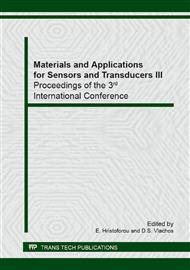p.474
p.478
p.483
p.487
p.491
p.495
p.499
p.503
p.507
Enhanced Sensitivity of Pt/NiO Gate Based AlGaN/GaN C-HEMT Hydrogen Sensor
Abstract:
In this article we demonstrate the high sensitivity AlGaN/GaN circular HEMT (C-HEMT) hydrogen gas sensor with new gate interfacial Pt/NiO layer. The wide band-gap III-nitride semiconductor heterostructure allows the sensor operation at elevated temperatures. Likewise, the C-HEMT sensing device is easy to prepare because the MESA insulation step can be omitted. Moreover, the I-V characteristics of ring gate diodes with a dominant thermionic emission of electrons can be easly achieved by elimination of tunneling currents induced on the MESA-etched edges. The Pt/NiO stacked gate absorption layer has nanocrystalline structure, what increases the surface-to-volume ratio. Consequently, the hydrogen gas is more efficiently dissociated at low temperature. Comparing to reference Pt/AlGaN/GaN diode sensor, the optimum operation temperature decreases from 250 oC towards 50oC and the hydrogen detection efficiency is enhanced about 10 times. This is desirable for battery-powered sensors with low current consumption. On the other hand, the fabricated sensor shows longer reaction and regeneration time constants. This is due to longer diffusion path that hydrogen atoms must overcome to reach the AlGaN semiconductor surface.
Info:
Periodical:
Pages:
491-494
Citation:
Online since:
April 2014
Authors:
Price:
Сopyright:
© 2014 Trans Tech Publications Ltd. All Rights Reserved
Share:
Citation:


